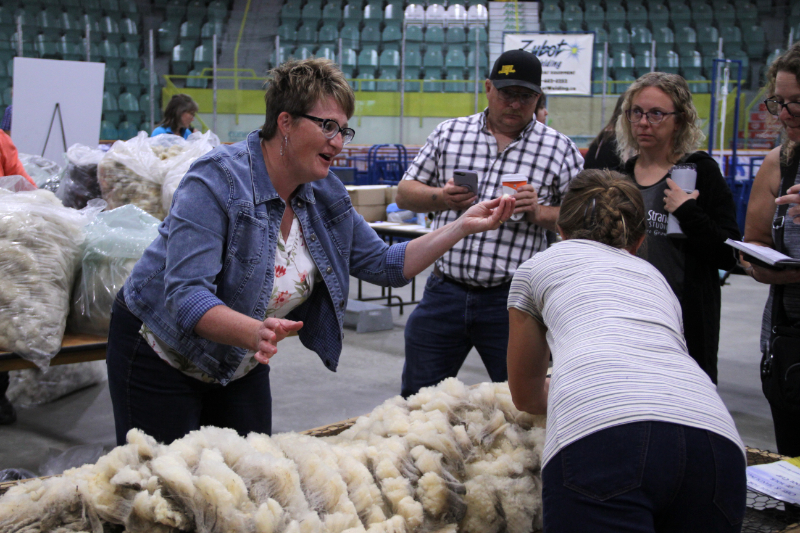The Elgar Petersen Arena was a real barn over the weekend.
While it’s usually full of Broncos, it was full of sheep as producers from across the province flocked to Humboldt over the weekend for the Grasslands Exhibition.
With every aspect of the sheep production industry represented, producers and the public alike got to partake in the tradeshow and sheep show, and learn about everything from the work of stock dogs to how best to prepare their wool and fleece for the fabrics industry.
The show was back after two years of COVID and vice-president of the Saskatchewan Sheep Breeders Association told farmnewsNOW that while sheep producers were able to take their show online during that time, coming out in person meant so much more.
“Unfortunately, with a pandemic, sometimes what our goals and mission were had to change up a little bit. It’s nice to be able to provide an avenue for some of our exhibitors to come out and show and then sell their livestock but also it’s nice to be able to see one another again. In our industry, we’re pretty close-knit.”
Nearly 130 sheep were brought in for the show and sale by 22 consignors, said MacDougall.
The crowd was mixed, she said, with some producers looking to diversify their herds while others coming to have a look are livestock producers looking to get into sheep for the first time.
 Judge James Hewson scrutinizes the Canadian Arcott ewe lambs at the Grasslands Sheep Exhibition. (Becky Zimmer/farmnewsNOW Staff)
Judge James Hewson scrutinizes the Canadian Arcott ewe lambs at the Grasslands Sheep Exhibition. (Becky Zimmer/farmnewsNOW Staff)That seems to depend on how crops are doing, said MacDougall, as areas in the province currently have too much water or not enough. Diversification on the farm, from a livestock commodity standpoint, depends on making a living on the market and right now, sheep markets are going strong.
“There is room for new people to come in,” said MacDougall. “The demand for lamb is so high that we actually can’t maintain it. We really could see our flocks increase, whether that’ll happen or not, hopefully, but there’s room for that to happen.”
Those looking to expand or start their herd got a good look at many different purebred sheep breeds, including breed classes for Suffolk and Canadian Arcot. The Any Other Breed classes featured several others like Rideau Arcotts, Ile de France, North Country Cheviot, Texel Charollais, and Dorset breeds to name a few that are being produced in the province and across Canada, as well as crossbreeds that were being sold commercially.
Beyond the meat production side of the industry, MacDougall said there are so many more sides that people perceived.
Lonnie Penner led the stock dog demonstrations as several dogs showed off their sheep herding skills. As producers get older, he said these helpful companions can take a load off moving sheep and cattle around.
“Spending the time learning the stockmanship and then learning to work with the dog can save you so much effort.”
In the province there are plenty of people who breed stock dogs and provide training to help producers started, Penner told farmnewsNOW.
The stock dogs also got to demonstrate the pen system locally welded by Zubot Welding out of Burr, Sask.
Another big side of the show was shearing and skirting demonstrations.
Brooke Aitken has about 350 sheep on her farm near Eyebrow, Sask. She was part of the Fibre Festival and while she does not sheer or judges the fibres coming off the sheep, she is part of a dedicated crew that wants to bring the fibre industry to the forefront of sheep production.
Sheep shearing is the necessity of the industry but the majority of producers just see it as a waste product, either burning it or composting it, Aitken told farmnewsNOW.
“The price of the wool is not enough to encourage people to do things to add that value to it or even just to use what they’ve got. There’s a little bit more interest but unfortunately, the majority of producers don’t really consider it a marketable product.”
In an attempt to grow the wool industry, Aitken was at the show to demonstrate how producers can prepare the fibres and make them more marketable.
Joanne Petersen has her own 40-head herd around Mossbank, Sask. and even being a sheep producer for the past 18 years, this was the first time Petersen, and her cattle producer husband, Dale, were able to attend the show.
Whenever she sent wool out to the Canadian Co-operative Wool Growers, she was docked a significant amount due to the way she prepared her wool. Learning from Aitken was a great experience, she said, and now has the knowledge to better market her wool, everything from the quality of cuts and how to separate it and get the vegetation out of the cuts.
 Mossbank sheep producer, Joanne Petersen, gets some pointers about preparing her wool for shipping. (Becky Zimmer/farmnewsNOW Staff)
Mossbank sheep producer, Joanne Petersen, gets some pointers about preparing her wool for shipping. (Becky Zimmer/farmnewsNOW Staff)“I just bundle it together and plop it in the bag, so this was really good to learn,” Petersen told farmnewsNOW.
The sheep exhibition has taken place in Humboldt since 2015.
—
becky.zimmer@pattisonmedia.com
On Twitter: @bex_zim








